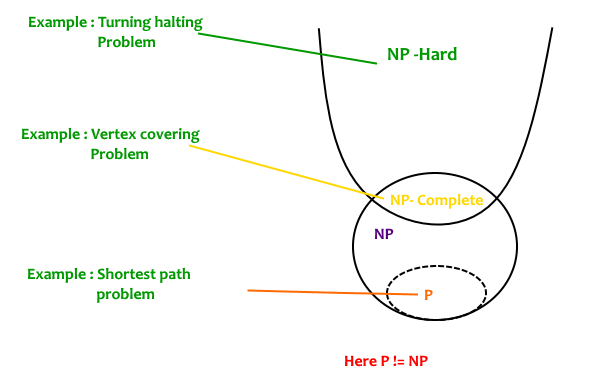NP-Completeness | Set 1 (Introduction)
We have been writing about efficient algorithms to solve complex problems, like shortest path, Euler graph, minimum spanning tree, etc. Those were all success stories of algorithm designers. In this post, failure stories of computer science are discussed.
Can all computational problems be solved by a computer?
There are computational problems that can not be solved by algorithms
even with unlimited time. For example Turing Halting problem (Given a
program and an input, whether the program will eventually halt when run
with that input, or will run forever). Alan Turing proved that general
algorithm to solve the halting problem for all possible program-input
pairs cannot exist. A key part of the proof is, Turing machine was used
as a mathematical definition of a computer and program (Source Halting Problem).
Status of NP Complete
problems is another failure story, NP complete problems are problems
whose status is unknown. No polynomial time algorithm has yet been
discovered for any NP complete problem, nor has anybody yet been able to
prove that no polynomial-time algorithm exist for any of them. The
interesting part is, if any one of the NP complete problems can be
solved in polynomial time, then all of them can be solved.
What are NP, P, NP-complete and NP-Hard problems?
P is set of problems that can be solved by a deterministic Turing machine in Polynomial time.
NP is set of decision problems that can be solved by a Non-deterministic Turing Machine in Polynomial
time. P is subset of NP (any problem that can be solved by
deterministic machine in polynomial time can also be solved by
non-deterministic machine in polynomial time).
Informally, NP is set
of decision problems which can be solved by a polynomial time via a
“Lucky Algorithm”, a magical algorithm that always makes a right guess
among the given set of choices (Source Ref 1).
NP-complete problems are the hardest problems in NP set. A decision problem L is NP-complete if:
1) L is in NP (Any given solution for NP-complete problems can be verified quickly, but there is no efficient known solution).
2) Every problem in NP is reducible to L in polynomial time (Reduction is defined below).
A problem is NP-Hard if it follows property 2 mentioned above, doesn’t need to follow property 1. Therefore, NP-Complete set is also a subset of NP-Hard set.

Decision vs Optimization Problems
NP-completeness
applies to the realm of decision problems. It was set up this way
because it’s easier to compare the difficulty of decision problems than
that of optimization problems. In reality, though, being able to solve
a decision problem in polynomial time will often permit us to solve the
corresponding optimization problem in polynomial time (using a
polynomial number of calls to the decision problem). So, discussing the
difficulty of decision problems is often really equivalent to discussing
the difficulty of optimization problems. (Source Ref 2).
For example, consider the vertex cover problem
(Given a graph, find out the minimum sized vertex set that covers all
edges). It is an optimization problem. Corresponding decision problem
is, given undirected graph G and k, is there a vertex cover of size k?
Let L1 and L2 be two decision problems. Suppose algorithm A2 solves L2. That is, if y is an input for L2 then algorithm A2 will answer Yes or No depending upon whether y belongs to L2 or not.
The idea is to find a transformation from L1 to L2 so that the algorithm A2 can be part of an algorithm A1 to solve L1.
Learning reduction in general is very important. For example, if we have library functions to solve certain problem and if we can reduce a new problem to one of the solved problems, we save a lot of time. Consider the example of a problem where we have to find minimum product path in a given directed graph where product of path is multiplication of weights of edges along the path. If we have code for Dijkstra’s algorithm to find shortest path, we can take log of all weights and use Dijkstra’s algorithm to find the minimum product path rather than writing a fresh code for this new problem.
How to prove that a given problem is NP complete?
From
the definition of NP-complete, it appears impossible to prove that a
problem L is NP-Complete. By definition, it requires us to that show
every problem in NP is polynomial time reducible to L. Fortunately,
there is an alternate way to prove it. The idea is to take a known
NP-Complete problem and reduce it to L. If polynomial time reduction is
possible, we can prove that L is NP-Complete by transitivity of
reduction (If a NP-Complete problem is reducible to L in polynomial
time, then all problems are reducible to L in polynomial time).
What was the first problem proved as NP-Complete?
There must be some first NP-Complete problem proved by definition of NP-Complete problems. SAT (Boolean satisfiability problem) is the first NP-Complete problem proved by Cook (See CLRS book for proof).
It is always useful to know about NP-Completeness even for engineers. Suppose you are asked to write an efficient algorithm to solve an extremely important problem for your company. After a lot of thinking, you can only come up exponential time approach which is impractical. If you don’t know about NP-Completeness, you can only say that I could not come with an efficient algorithm. If you know about NP-Completeness and prove that the problem as NP-complete, you can proudly say that the polynomial time solution is unlikely to exist. If there is a polynomial time solution possible, then that solution solves a big problem of computer science many scientists have been trying for years.
We will soon be discussing more NP-Complete problems and their proof for NP-Completeness.
References:
MIT Video Lecture on Computational Complexity
Introduction to Algorithms 3rd Edition by Clifford Stein, Thomas H. Cormen, Charles E. Leiserson, Ronald L. Rivest
http://www.ics.uci.edu/~eppstein/161/960312.html




0 Comments